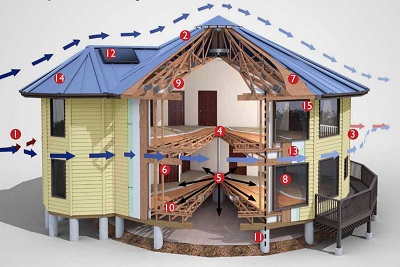 Friday, April 19, 2024
Friday, April 19, 2024  Friday, April 19, 2024
Friday, April 19, 2024 
Flooding, drought, hurricanes, wildfires — extreme weather events, once infrequent, are becoming more common and powerful due to climate change. At the same time, growing numbers of people worldwide are moving to cities. That’s a dangerous combination, since urban populations are more at risk of disruption from the effects of global warming. Millions of people worldwide might be putting themselves at risk just because of where they live.
But simply relocating populations at risk only gets us so far — for instance, relocating a subsistence-based fishing village inland would leave people without livelihoods, and sprawling cities into new developments would mean disrupting even more of our natural environment. We have to find a more sustainable long-term solution — homes hardy enough to survive more frequent extreme weather events, and with minimal carbon footprints to not make them worse.
Skilled designers, architects, and engineers have been hard at work, looking for a solution that tries to tackle both of these issues: develop homes that can survive future conditions on Earth, without damaging our environment even further. Here are some of the most creative ways we can adapt where and how we live to mitigate the negative consequences of climate change.
Seasteading, the practice of establishing permanent settlements on structures located in areas of sea outside the jurisdiction of any country, is becoming more mainstream. In April 2017, the term was added to the Oxford English Dictionary. It marks the emergence of a new way of living that takes advantage of the other 71% of our planet’s surface — the ocean.
Sea levels are rising even faster than experts had predicted, so private development firms, governments, and researchers have turned their attention to making the oceans our new home. The open water, distant from any nearby land, isn’t the most inviting or accessible place to settle, but as polar ice caps melt and more populated areas begin to flood, we might start running out of space on dry land.
Many projects, some in progress and some already complete, have made use of the ocean by creating new land with sand or landfill. Most notably, land reclamation sites in the United Arab Emirates such as Palm Jumeirah in Dubai, have expanded habitable territory at an enormous scale.
But simply adding more land doesn’t address the incoming tide and rising sea levels. The alternative: settling on the surface of the water on a floating island.
Watch the video and learn more about the benefits of joining Construction Links Network – the peer-to-peer network sharing platform for the construction, building and design community.
Ideal for YOUR Press Releases | Project Updates | New Appointments | Awards & Milestones | Company News | New Products/Services | Brochures | Videos | Infographics | Blog Sharing | Events and More